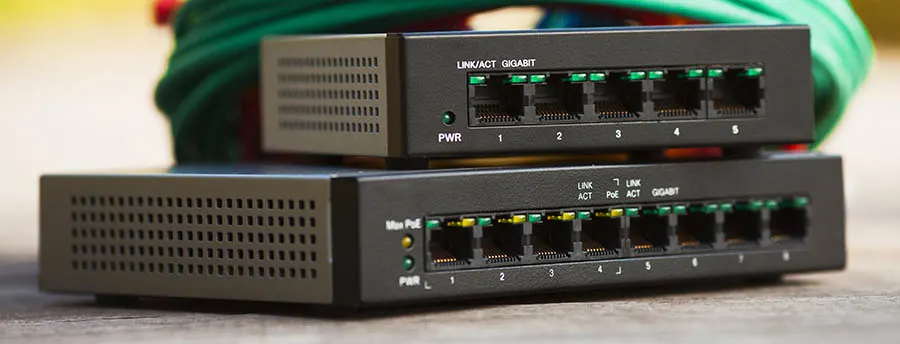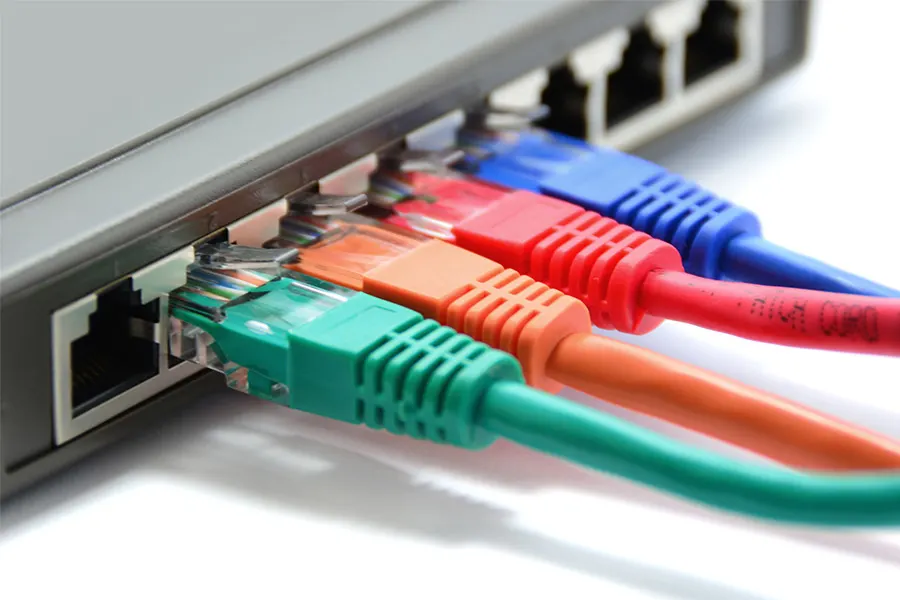Does your home or office have a limited amount of ethernet cables available? If so, you likely have been struggling to connect multiple devices through ethernet and have considered splitting your ethernet cable. Your band-aid solution may be to swap the cable from device to device, but that gets old quickly. Limited ethernet connections are a real issue and can cause considerable frustrations, but easy solutions are available.
The best way to split an ethernet cable to multiple devices is by using a network switch. You can also recycle an old router, and use it as a network switch. The easiest and quickest cable-management solution is to use an Ethernet Sharing kit.
There are different pros and cons for each method that’s listed above. To learn which option might be the best for you, continue reading!
Can You Split Ethernet Cable?
The short answer is yes, you can split an Ethernet cable, but there are some limitations to consider.
Ethernet splitters and adapters are two common ways to split an Ethernet cable. A splitter is a simple device with three Ethernet ports that allows you to run two Ethernet devices along a single cable without having to purchase and power a switch or run more cables.
An adapter, on the other hand, lets you take a single Ethernet connection from a wall socket or direct connection to your network’s router and spread it to multiple devices around the room.
While Ethernet splitters and adapters can be a convenient way to expand your network, there are some limitations to consider. For example, splitting an Ethernet cable can reduce the bandwidth available to each device, which can slow down your network. Additionally, Ethernet splitters and adapters may not work with all types of Ethernet cables, so it’s important to check the compatibility before you buy anything. Let’s look at the most common solutions next.
What Are Your Options For Splitting Ethernet?
Here’s a quick summary of the most common methods, how difficult we consider them, and how big of an impact on your network speed they could have:
| Method | Difficulty | Impact on Network Speed | Cost Effectiveness |
|---|---|---|---|
| Ethernet Network Switch | Easy | Minimal | High |
| Ethernet Hub | Easy | Significant (If multiple devices are connected) | Medium (if you have an existing hub) |
| Split (Multi-Head) Ethernet Cable | Easy | Significant (Only one device at a time) | Low |
| Ethernet Cable Sharing Kit | Medium (Requires proper setup and CAT-5E or above cable) | Minimal | Medium (Depends on cost of the kit, but typically much less than a network switch) |
| Old Router as Network Switch | Medium (Requires disabling firewalls and DHCP) | Minimal | Low (if you have an existing router) |
We’ll cover all these tactics in depth below, so let’s get started!
Pro Tip: To preserve bandwidth, we recommend using an old router as the best first option to try, and if you only have one device to add, using an Ethernet Cable Sharing Kit after that. If you’re using serious data across all connections, an Ethernet Network Switch is a better option.
Using an Ethernet Network Switch to Split Your Ethernet Cable
A gigabit ethernet network switch is a great tool. We have a more in-depth article on these devices and how they fit in with other PoE and ethernet-connected equipment, but the key idea here is that this is the best and most reliable method to split a single ethernet cable into 2 or more connections. Especially for gamers (see forum links here and here), we recommend a switch for connecting your PC and Gaming console, for instance, because those are applications where you probably don’t want traffic to one cut off when using the other.
How Do Ethernet Switches Work?

The network switch connects to the single ethernet cable from your router or modem on one end, and any other devices you’d like to provide internet to on the other. Network switches work by performing packet switching to provide data to multiple devices through a single ethernet cable. Packet switching is an efficient method of transferring multiple chunks of data that provides the data in packets only to the devices that need it.
Since the data packets are only provided to the intended device and not shared with the other devices connected through the network switch, the speed of the network isn’t slowed down by unnecessary extra traffic. Keeping your network speed fast and smooth is ideal when you have multiple devices sharing the connection.
A network switch works like a 2-way call, only the provider of the information and the information receiver hear each other. Other methods of ethernet splitting use methods that are like the information provider shouting on speakerphone to all the connected devices at once. Only a switch offers the dedicated channels that really give you the effect of having two dedicated ethernet feeds to each device.
And one nice feature of these devices is that ethernet switches provide their extra connections through hardware connections automatically, and don’t require any software to be installed on your devices.
How Much Do Ethernet Switches Cost?

There are many cost-effective ethernet switches available, like the TP-Link TL-SG105 5 Port Gigabit Unmanaged Ethernet Network Switch (on Amazon). You should be able to find ethernet network switches with anywhere from 5 to 12 or more extra ethernet connections for sale at online merchants.
You can get a big expensive ethernet switch if you need one, but if you’re just needing to split 1 connection to 2, you can find options in the <$20 that will work just fine (like the Miraview 2Port RJ45 Gigabit Ethernet RJ45 Network Switch (also on Amazon).
Using an Ethernet Hub To Split Ethernet
An ethernet hub is another method to split an ethernet cable. Ethernet hubs are extremely rare nowadays since the technology has improved with Ethernet switches. If you happen to find an Ethernet hub, you can dust it off and use it to split your ethernet. Ethernet hubs literally split the ethernet connection into two branches.
They do not perform packet switching, instead, hubs repeat all of the data to all of the devices connected to it. Providing all of the data to all devices, all the time clogs up the network and can slow download and upload speeds to a crawl. This is why the technology has been somewhat phased out, wit barely any options for sale on Amazon.
If you plan to use many devices through a single ethernet connection with a hub, beware! Your download speed will go down the drain because of the repeating of data. However, ethernet hubs are a viable option if you only have a few devices connected.
And note that different scales of internet speed use different amounts of the Ethernet cable. If you’re not going to try and use one cable to support your whole system, you don’t need to care about this, but if you’re concerned with lot’s of data getting to and from lot’s of places, then consider the discussion here (forum link) on the limitations of ethernet wires based on internet speed.
Using a Split (Multi-Head) Ethernet Cable
An ethernet splitter cable is another solution to the single ethernet cable problem but by far the worst one. Split ethernet cables, like the AILANSI RJ45 Ethernet Splitter Cable (on Amazon), offer no benefit besides being able to physically connect two devices to the ethernet cable at the same time. Even though they are physically connected, you can only download from one device at a time.
Device A cannot make use of the ethernet connection while device B is using the connection and vice-versa. One device at a time isn’t fun and isn’t a great solution if you want to use 2 or more devices through the same ethernet cable at once.
A good network switch can be purchased for only $4 to $5 more than a split ethernet cable, so you can probably rule out this option pretty quickly if you need the better features that a switch provides.
How To Use An Ethernet Cable Sharing Kit
An ethernet cable sharing kit is a great way to split your ethernet cable while reducing cable clutter. However, ethernet cable sharing is only a useful option if you have a router with multiple ethernet ports available and a single CAT-5E (or above) ethernet cable that is running to another area of the home or office.
We’ll explain how these kits work below, but go ahead and pull up the product page for the Cable Matters Ethernet Cable Share Kit (on Amazon) so you can see what these components look like. That will make this explanation easier to understand.
The ethernet cable sharing kit comes with 2 adapters, let’s call them adapter A and adapter B. Adapter A has 2 input ethernet ports and 1 output ethernet port, adapter B has 1 input ethernet port and 2 output ethernet ports.
- Adapter A’s 2 inputs connect to 2 ethernet ports on your router.
- Adapter A’s 1 output ethernet connection connects to your single ethernet cable (or to a wall plate that is wired to ethernet in another room).
- Adapter B’s 1 input connects to the other end of the ethernet cable (or the ethernet wall plate in the room away from the router)
- Adapter B’s 2 outputs connect to your 2 devices like your laptop and desktop computers at the same time.
In summary, an ethernet cable sharing kit reduces 2 connections from your router to 1 ethernet cable, then re-expands the 1 ethernet cable to 2 connections in another area/room of your home or office. The single ethernet cable running between both adapters must be a CAT-5E or higher ethernet cable and must have all 4 pairs of wires connected in order for this method to work.
Ethernet cable sharing sounds complicated, but you will be running 2 devices smoothly with no negative network speed impacts once it is set up. Ethernet cable sharing is limited to only 2 devices. If you need to connect more than 2 devices- use an ethernet network switch. It is an easier setup and you can find switches with up to 8 or more extra connections.
Use a Router or Modem as an Ethernet Splitter
You can use an extra router as an ethernet switch! All you have to do is connect your single ethernet cable into the input of the router and then use the extra ethernet ports to connect to your extra devices. Viola- you’ve got yet another solution to your single ethernet cable problem! Using a router to split ethernet is a great solution, on par with using an ethernet network switch!
You may need to disable firewalls and DHCP on the extra router to make things run fast and smoothly. If you do not already have a spare router lying around, it’s probably not worth it to go out and buy another router to split your ethernet.
Buy a gigabit ethernet network switch instead, they are 3-5 times cheaper than routers and perform the function just as well. If you do have a spare router, make sure it works first. Secondly, if it is very old- it may be limited on the data transfer speed it can provide. A quick investigation of the hardware specs will give you some confidence if your old/spare router can do the job for you.
Conclusion
Splitting a single ethernet cable to connect multiple devices is not rocket science and also should not involve cutting into your ethernet cable. The best solution is to buy an ethernet network switch or make use of a spare router you have laying around. Some other options could work for you too, but are not as fun and have limitations that network switches do not have.
